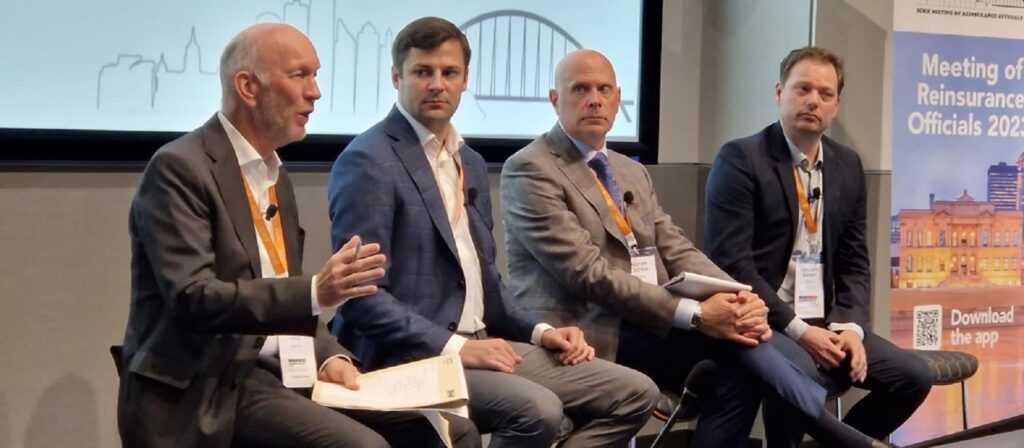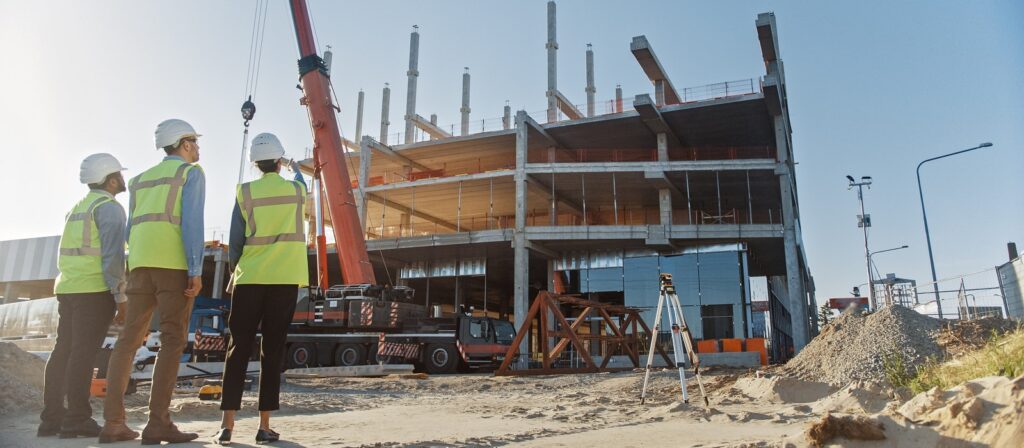Shaun Sinniah:
My name is Shaun Sinniah, or as I’m known in ICMIF, the “other Shaun.” So great to meet some of you, which I’m sure we spent some time together in Rome. Love to just take half an hour to rocket through some of the observations that we’ve made around the 1/1 renewals for reinsurance and then maybe some of the positioning for the rest of the year.
My role at Guy Carpenter is I lead our placement and distribution efforts, which is effectively our outwards business into reinsurers. So I look after the $58 billion that we place into the market, try to understand what are the dynamics in that, who are our core markets, what are we placing into them, where are we placing it to them, and how do we do that all a lot more efficiently for the betterment of our clients and to drive client outcomes.
So without wasting any more time, just in terms of today’s agenda, we’ll go through a little bit around the dynamics of the reinsurance market. Some of the macro themes that we see will go into the overview of what we saw in North American international, some of the renewals around the global specialties world. And we’ll end with a brief Q&A.
I will say, the reinsurance world is probably, it is a global environment. So there are forces which are not specific to any one region or any one type of line of business. It is a marketplace, and fundamentally it’s driven by supply and demand dynamics. The way that we look at reinsurance and our market participants really from a macro perspective is through the lens of growth, volatility, and capital. So really what we’ve seen at the last 1/1 renewals and what we saw … Sorry, I’m just trying to admit a few people. What we saw at the last 1/1 renewals was really a dynamic where there was a shift of the equilibrium away from perhaps mutual companies, carriers, and a little bit more towards reinsurers as they struggled with many of these macro factors.
Within growth we’ve seen double-digit premium growth continue through 2022, fueled by economic growth. The 1/1 renewals were evolving and they were an evolving story of supply and demand, like I said. It was huge variability by region or by line of business, and frankly by cedant type. Not as much as we thought there would be. We thought there would be greater differentiation between good cedants and ones who were maybe struggling, and we didn’t see that as much as we thought. And I think that’s particularly important when we’re talking about the mutual and cooperative space.
In terms of volatility, we will talk a little bit about large catastrophe losses. This is a third year in the last six where we’ve got over $100 billion of cap losses. That’s excluding the impact of COVID-19 claims. And also, there was I would say a huge flux in the market, which resulted in unrealized investment losses and impairments to many of the large reinsurers, such as Swiss Re and SCOR. In terms of capital, we’ll talk a little bit about the changes in capital levels within the industry. Again, within the supply and demand dynamic. That overall supply of capital is so important in driving pricing, attachment point terms and conditions.
And then really the last topic that we want to look at is those 2023 hot topics. As we look forward, what are the things that are coming into play? So inflation, the risk of recession, financial market conditions are really important and we’ll spend a little bit of time on that.
The one that really surprised me personally because I’m quite close to it and I spend a lot of time thinking about it, is ESG. So ESG we thought would be a very large factor in the 1/1 renewals and frankly, they just weren’t. There was really very little to do with terms and conditions or exclusions around ESG or pricing impact. And bar a few markets pulling out on the direct side and therefore the reinsurance market being impacted by that, there was really very little around that. We expect that to change fundamentally as we go into the latter part of 2023. And that’s something that myself, the team and Guy Carpenter are looking forward to really leading some of that conversation.
In terms of the overall rate-on-line movements within the property cat space, this is GCs property cat index, which we bases rate movements to 2000. And we’ve overlaid it against major shifts or major losses. 9/11, hurricanes Katrina, Rita, Wilma, Christchurch Hurricane Harvey, and then Ida and Uri and the European floods. And what you’ll see is, as things ebb and flow, really in the last three to four years we’ve seen a significant increase in rates. And that’s impacted everyone. And while the US has got a lot of press, I think concerned to Europe there were significant increases, as well as in Asia where we’re still seeing them. And in Latin America there will be expected increases at mid-year.
So if you had a renewal at one 1/1 or you’re in the process of having a renewal, how has your overall experience been? Has it been positive, has it been neutral or has it been negative? And then if you flick to question two as well, if you had a renewal at one 1/1, do you think that being a mutual or a cooperative helped differentiate you? Yes, you think they have for the better, yes, for the worse, or no, not at all.
So really the point of asking you that is, I think a lot of our cedants found this renewal time to be very tense, very stressed, far more difficult than perhaps any of us thought going into Monte Carlo. And really as the market evolved post hurricanes, we really saw it becoming more difficult and that supply and demand dynamic changing. And really what, again, like I was saying earlier, we saw less differentiation between what I would classify as good risks, many of you in the ICMIF family, we would classify as good risks. Good policyholder logic, no real crazy growing into different areas, much more a sensible business plan. We saw probably less differentiation than we have in previous years.
Pivoting back to what we saw in terms of the macro picture, I think 2022 was another high CAT year. So for the third time in six years we had over $100 billion of CAT losses. And I think interestingly as well, Swiss Re’s own stats say that 70% of CAT losses in 2022 were from secondary perils. Now that’s really interesting, because as you look at retrocession of retro providers and the ILS markets, as well as people like the cat bond markets, they rely on these models. And things which aren’t modelable are very hard to sell to your investors, they’re very hard to understand and quantify. And what they’re noticing is more for preponderance of these losses coming through. So really a very interesting dynamic.
This has led to much more for the first time the combined ratios of reinsurers really varying. And again, this is something we’ll talk about over a couple of these slides is their combined performance between 2012 and 2016. So having combined ratios for a reinsurer for about 90% seem like a fantastic result. But I think we should keep in mind that during this time it was a very benign cat environment. So those loss ratios were you could argue artificially depressed, or just a beneficiary of a benign cat period. And we’ll see this as we fast-forward into how reinsurers have really looked at their cost of equity in recent years.
So if we look at their returns, return on adjusted equity in the dark blue and the blue line, which is the five-year weighted average, you’ll see those benign cat years have resulted in some great returns to their shareholders. However, as those great results have fueled pricing demands, the market has gotten softer, many clients have gotten better deals rightfully so. And that is also combined with an increase in cat events, depressed their returns. And really their five-year weighted average of 6.2 was well below their cost of capital now.
And that, coupled with the preponderance of secondary perils, has really led to, for the first time, a reduction in dedicated capital coming into the insurance industry. So 2021, by our estimations and AM Best’s estimates, we would see about $570 billion of capital. We believe that fell to $530 billion. Interestingly, the dark blue, which is the alternative capital piece, we would’ve expected that to come down a little bit more, and I think that may be something that we will experience in 2023.
The last thing I’ll say from a macro perspective before we go into the individual movements within lines of business and regions is, this is from Bank of America and it’s a global financial survey done with a number of CEOs and senior members within the banking world. And it’s asked them in December 2022, “What were some of your largest concerns,” and then flicked that to January 23 and to see how these have changed. So while the metric and the quantum may have changed, we saw really most of them to be maintained, with the exception of COVID-19, which unfortunately has made a resurgence in worry amongst the CEO group. But really, inflation, a global recession, central banks being hawkish, geopolitics worsening, and systemic credit events, are top of mind.
So really keep in mind the backdrop of the macroeconomics that we’ve been talking about, the supply and demand, the pressure that reinsurers have been under. And I think that helps understand maybe some of the pendulum moving away from carriers, from mutuals, from cooperatives, and perhaps more into the reinsurers’ favor. Hurricane Ian really was a precipice moment, where we went from perhaps being in a difficult but capable market, to being in one which was perhaps slightly more distressed than we had thought. You layer on inflation concerns of 10 to 15% on underlying valuations and just cost of rebuild, and that was also another driver. If you look at the large reinsurers, Swiss Re, Munich Re, Hannover Re, in their view of ’23, this is something that continues to worry them.
Reinsurers also had to change their view of risk, and I think that this is something which goes hand in hand with pricing. So when we think about economics, we think about pricing and we think about the attachment point of a program or the likelihood of a loss to attach into its first layer. And we saw that shift quite significantly as reinsurers tacked away from years of loan retentions and dealing with products such as aggregate covers into increased retentions. And we’ll come onto some of those metrics shortly.
During the renewal period, as things progressed, we found that the economics actually was solved, whether it was quickly or slowly, the economics was solved, probably a week, two weeks out. What was really more of a thing that got in the way of the process was this negotiation around terms and conditions, especially around loss occurrence definitions, treatment of terrorism, treatment of strike riot, civil commotion. These really were sticking points where reinsurers felt like they were promising too much coverage for what they were charging and they were really holding a line on this. And to a greater or lesser extent, some of that still exists and we’re still working through that.
I think we’ve already talked about many of these macro factors. We talked about raising inflation, interest rates moving up and therefore impairments on a reinsurer’s balance sheet. One of the things which we haven’t touched on was the ongoing war in the Ukraine. And I think that this is having a multitude of effects, whether it’s air cap and planes being grounded in Russia, all the way through to forcing exclusions and more in-depth understanding of war exclusions. And this is something which we will see continuing, especially pronounced in the specialty market.
We talked a little bit about climate change anxiety at the beginning, but I think that that will start to be factored in, again coupled with the 70% of cat losses being from secondary perils. Global cat loss activity obviously sucking capital out of the industry, and then a constrained ILS and retro market. I’m sure many of you are au fait with the retro market, but this is really where reinsurers look for some form of protection on their highly volatile books, either into ILS markets, into other reinsurers who have a specific need, or into the capital markets. And where we’ve seen investors showing reticence to get in, that’s really put a squeeze on the retro market.
At one point in early December, we thought that we may have a truly disjointed market and one where it would be impossible to place risk at any price. But thankfully, as the reinsurers saw their primary pricing coming up, as they were able to manage their own volatility requirements and their own growth ambitions, and they were able to pair that off with either a more moderated view of their retro requirements or were willing to pay the increases in order to secure coverage where it was most needed.
We talked a little bit about the global rate-on-line index. The US property and cat index, we saw really a 31% increase from a risk adjusted basis. And this is where we felt the increase is most pronounced. I think the US has had a deterioration of losses. There have been a number of secondary perils, whether it’s California wildfire or the big freeze in Buffalo just before Christmas as well. So we saw a big increase in the US.
Interestingly, if you think back to my comments around the attachment point of these programs, we found that the medium attachment return period, so i.e. are we talking about a one in four, one in five, one in six attachment probability, that return period increased from five years to eight years and a 45% average retention increase in dollars. Now that I think is a major, if I could use the terminology win, for reinsurers, as they look to really get more risk adequacy.
The European rate-on-line index was also up approximately 30%. I will say that some of these figures are skewed by a few of the globals within Europe, and generally most of the rest of the group were actually seeing some slightly higher increases. Again, this is pretty pronounced when you consider a slow decline really from 2002, 2003, to the levels that we were at in 2020.
Now the UK is an interesting market. While we saw the biggest increases in 25 to 30 years, they were nowhere near the big peaks of the early and mid ’90s, and also probably slightly less distributed throughout the book as we saw in places like Europe and the US. What we found in the UK was they were focused really on a few different cedants whose results have been very poor. And one of them you might have seen in the news due to a few losses, has had a significant impact on their share price and a change in the majority of their C-suite.
I think this is also, if I could do a shameless plug for Guy Carpenter if you’d allow me, but I think the UK was one area where I saw a real holding of the line for client benefit for our clients. Not to say that this didn’t happen everywhere, I think it did happen everywhere, but in the UK we hold a majority of the cat limit that’s placed in the market. So when we were refusing to accept terms which were more restrictive around flood, in terms of hours clauses, and in terms of the move to a named perils-basis, we were able to have an outsized impact on the market, and that’s something that really we’re very proud of.
Asia, so Asia I think is a very interesting area, because Asia everyone thinks is dominated by the mid-year renewals in Australia and Japan, and to a certain extent it absolutely is. But I think Asia is also one where there’s a lot of business in Southeast Asia, in Korea, at 1/1. And we saw this really increase pretty significantly for the Asian market. Not only were there pricing increases as demonstrated here, but there was also a significant increase in retentions and major remediation around contract language.
Now the Japanese renewals are drawing to an end and I don’t want to prejudge what the outcome would be, but our view really is that while the renewals have been late, they’ve actually been very orderly. Our first renewal meeting for the Japanese renewal took place on the 3rd of January at 8:00 AM, as you’d expect. We got right into it with our clients. And we feel like reinsurers have really learned a lot from their 1/1 experience in terms of how to deal with clients, maintaining communication which is clear and crisp and consistent, and now they have a better understanding of their own retro requirements.
Inflation has played much less of a part to play in Japan as it has in Europe, for obvious reasons. And we think that this is something which has held our Japanese cedants in good stead. We’ve seen pressure on the deployment point or the attachment point from really that four to five-year mark up the programs a little bit. Whilst we don’t really necessarily think this is applied to the Japanese mutuals, who are more insulated again from the effects of inflation, and so no structural adjustments are expected.
For large non-life insurers there will be some upward movement on return periods, if they haven’t already been done in previous years. There are just a few remaining Japanese aggregate covers out in the market. These will probably need to be restructured again as reinsurers look at the viability of that product and the attachment point. And the fire programs have looked at high-loss exposure, so those have had to be augmented as well. So that’s really our view of Asia Pacific.
I spent a lot of time talking about the property cat market specifically, because I think that has been a major driver in the market dynamics and the first point where we felt a lot of pain points. I think touching very quickly on the casualty market and the specialty market, I think the casualty market has a lot of different dynamics going through it and I think whether you’re in different regions, you’re going to be dealing with different issues. For reinsurers, casualty does include the financial lines, business and it’ll be interesting to see what the recent bank, I don’t want to call them failures, but bank issues in the US and in other parts of Europe will have on this.
What I will say is that there was rate movement in favor of reinsurers within the casualty space, where pricing has increased. It’s really been dependent on loss versus non loss impacted programs. And we’ve seen a big, big spread even within loss impacted programs. Again, a slightly different view from the property cap placements. In the UK the motor book has moved quite a bit, and there was clear daylight again between loss impact and non loss impacted UK motor writers.
In terms of our specialty business, we talked a little bit about the retro market at 1/1. What was interesting is the initial quotes were coming at 35 to 65% up, and these layers are really not one or two rate-on-line layers. These are 25, 30 rate-on-line layers. So having a 65% movement on that really result in you getting into money swapping territory and really no real risk transfer. So while we saw a pretty broad and pretty high range in quoting, the firm orders were really coming in at 35 to 45% up. So this was really, as buyers of retro said, I can’t pay that price increase. It doesn’t really make any sense to me, and we need to pivot into something more sensible.
Ultimately, I will say that behavior from them has drove the retro market to come together. Personally, I’ve only been in the industry 12, 13 years, but I’ve never seen a market come together as quickly as the retro market at this renewal. I would say, it went from being a real concern to us, to being pretty close to done within a four to six working day period. So real, real quick movement, and I think the market came to an understanding.
The marine market continues to be very flexi. I think what we saw in terms of the composite deals, which were the ones which included a lot of the catch-all questions, so things like war, terror, other inland marine, which includes some construction put in there. I think we saw a bifurcation within some programs unraveling and other programs holding together, and that really was determined by who your lead reinsurer was. We expect marine to continue with its rate increases. We expect much more of a focus on wordings, and much more of a focus on unbundling some composite deals.
I won’t touch on the aviation market for now, but the last one I’ll talk about is the credit, bond and political risk market for two reasons. I think number one is, it’s interesting for mutuals to understand this in cooperatives where the relationship to a credit union exists. And there we saw really commissions being flat to marginally down and session levels being flat to marginally down.
I think a lot of the losses that we expected from COVID did not materialize into the reinsurance world, and that has really driven very, very strong results, especially if you look at some of the large reinsurers who disclose their credit results. These are running in the teens in terms of a loss ratio, or the low 20s. And interestingly contrasting to Marsh, which is MMC’S insurance broker, where we saw a lot of claims in the credit world and the bond world post-COVID. Now while that’s there and the premium spend has increased a little bit. I think this is one area which all of us are watching very closely, given the view on SVB and Credit Suisse and those wider economic pressures that we’re all facing.
So with that, I think the last question was just around looking at how we at Guy Carpenter, in partnership with ICMIF, look at how we can help support mutuals and cooperatives. And one of the things we were really noodling away on was, if there was a mutual-to-mutual reinsurance solution, would you be likely to use that? We will try to bring solutions through ICMIF to you, which can hopefully help you achieve your goals and support your policyholders in a more meaningful way.
The above text has been produced by machine transcription from the webinar recording. ICMIF has made every effort to ensure that transcriptions are as accurate as possible, however, in some cases some text may be incomplete or inaccurate due to inaudible passages or transcription errors. Listening to or watching the webinar recording will allow you to hear the full text as delivered during the webinar but this is available in English only. Our transcriptions are provided to enable members to select the language of their choosing using the dropdown menu above.





